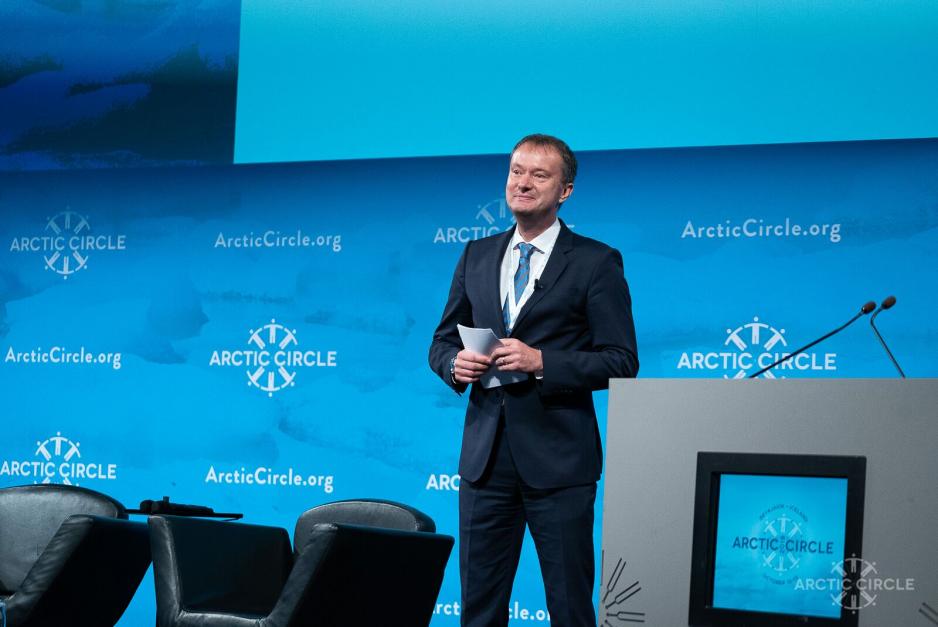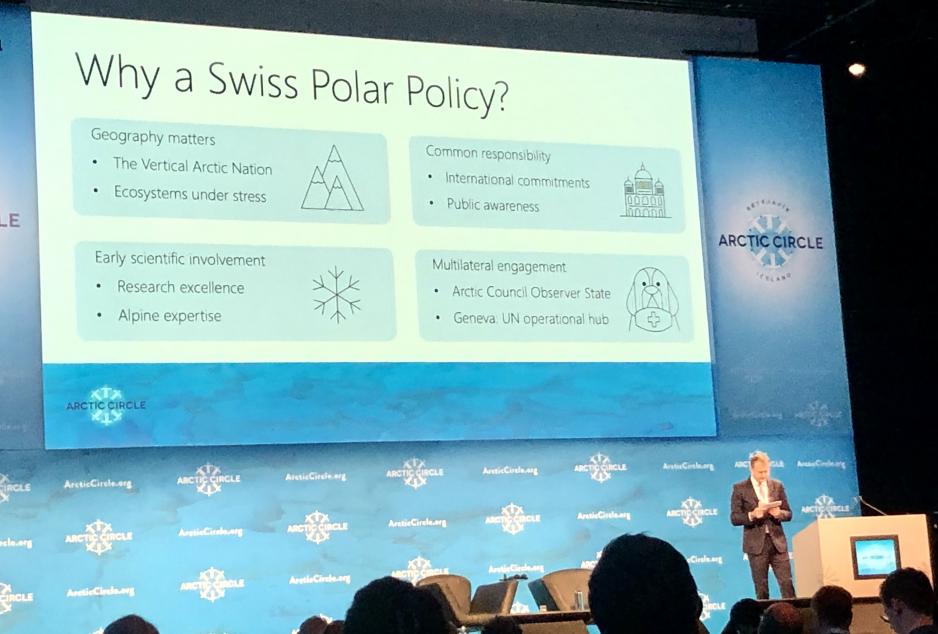The Swiss Arctic Policy Draw Parallels Between the High Altitude of the Alps and the Arctic

The Swiss Head of the Sectoral Foreign Policies Division, Ambassador Stefan Estermann, during his plenary session at the Arctic Circle Assembly session (Photo credit: Arctic Circle).
Ambassador Stefan Estermann argues that, in many ways, Switzerland representes a “vertical Arctic.” “It is a nice way to draw parallels between the high altitude of the Alps and the Arctic,” he says.
Switzerland boasts several centuries of experience with exploration and scientific ventures in the Arctic. It is partially on this legacy, and partially on the commonalities between Arctic and Alpine countries, that Berne has elaborated an Arctic policy.
In a plenary session at the recent Arctic Circle Assembly in Iceland, the Head of the Sectoral Foreign Policies Division, Ambassador Stefan Estermann, outlined the broad strokes of the Swiss approach.
In particular, he drew attention to the six pillars undergirding the Swiss strategy: supporting research institutions, promoting international scientific cooperation, leveraging private sector capacity, engaging in the international dialogue in the Arctic, addressing climate change, and showing solidarity with Indigenous peoples.
In order to get more details on how he understands Switzerland’s role in the Arctic, High North News sat down with Ambassador Estermann on the sidelines of the Assembly to ask him some questions.
Switzerland as the vertical Arctic
Echoing previous Swiss delegations to the Arctic Circle Assembly, Estermann argues that, in many ways, Switzerland represented a “vertical Arctic.”
“It is a nice way to draw parallels between the high altitude of the Alps and the Arctic,” he says, noting Switzerland’s strong alpine identity, “It really touches the heart of people. The same thing is true here. The Arctic, the ice—it’s close to your national identity.”
It is a nice way to draw parallels between the high altitude of the Alps and the Arctic.

Cloudy mountains in Swiss Alps, as seen from Bachalpsee lake in Swiss Alps. Photo credit Valcker on Flickr.
In addition to bridging identities, Estermann emphasizes that the Alpine-Arctic dialogue is an important tool to build empathy and understanding in the face of larger challenges such as climate change—a challenge he notes has recently been propelled to the forefront of Swiss foreign affairs.
“It’s a very nice way to engage in dialogue with our population and to show them the challenges with regard to climate change, for instance. I like this idea of creating the link between us and the Arctic.”
Building on an already strong Swiss presence in the region
While landlocked Switzerland may seem an unlikely place for polar research, the country boasts over a dozen research institutions with centuries of experience.
Instead of trying to reconfigure Switzerland’s approach to the region, Berne’s Arctic policy is better understood as supporting and consolidating this existing Swiss research presence. According to Estermann, “In one way, [the Swiss Arctic policy] is institutionalizing what Swiss civil society and what Swiss research institutions have already been doing in the Arctic for quite a while.”

The Swiss Head of the Sectoral Foreign Policies Division, Ambassador Stefan Estermann, presenting the Swiss Arctic strategy during Arctic Circle Assembly 2019. Photo: Siri Gulliksen Tømmerbakke
The goal is to support existing initiatives by providing a solid political framework through which they can have more visibility on the international stage.
“This is very much in the Swiss tradition,” argues Estermann, “We are a strong country, but we are a weak state administration. Our strength comes from civil society actors, from the research communities, and from economic actors. That is where our strengths lie, and we want to leverage this for our Arctic pursuits.”
Observer status at Arctic Council to support all members
Estermann sees a similar supporting role for Switzerland in the context of its 2017 adhesion to the Arctic Council as an observing member.
“Our Arctic strategy and our membership as part of the Arctic Council is giving all those members a kind of backing, or a frame if you want, to support what they are doing.
It is very important for us, just to listen, to become more knowledgeable about the challenges in the Arctic.
He further clarifies that “… for us of course it is very interesting to listen to the Arctic countries and listen to the Arctic peoples; the problems they face in the Arctic, how they see Arctic development—that is very important for us, just to listen, to become more knowledgeable about the challenges in the Arctic.”
This, he notes, is the main political benefit that Switzerland gains from being part of the Arctic Council.
The added value Switzerland brings to the Arctic
Beyond providing a political platform and support to Swiss institutions and Arctic Council members, Switzerland is hoping to lend its technological innovation to help tackle some of the issues facing the region.
This is particularly true of problems associated with climate change. State initiatives alone will not be enough if the private sector is not engaged in the solutions.
“We are facing huge challenges in terms of climate change,” notes Estermann, adding that “the only hope we have is massive technological innovation, to find alternatives to fossil fuels and carbon.”
